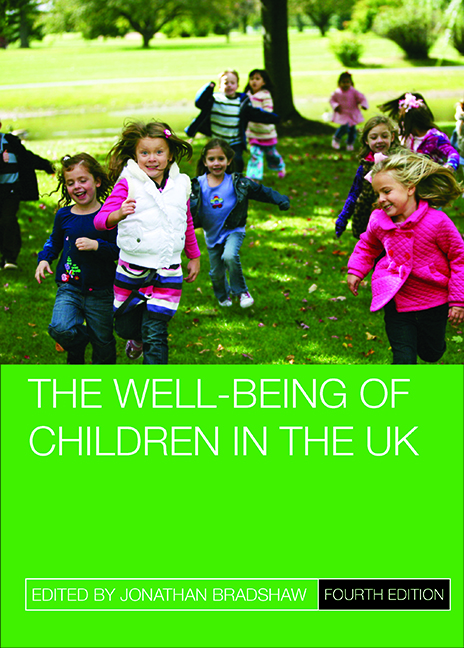Book contents
- Frontmatter
- Contents
- List of figures and tables
- List of abbreviations
- Notes on contributors
- Acknowledgements
- One Introduction
- Two Demography of childhood
- Three Child poverty and deprivation
- Four Physical health
- Five Subjective well-being and mental health
- Six Education
- Seven Housing and the environment for children
- Eight Children’s time and space
- Nine Children and young people in care and leaving care
- Ten Child maltreatment
- Eleven Childcare and early years
- Twelve Children, crime and correction
- Thirteen Conclusion
- Bibliography
- Index
Twelve - Children, crime and correction
Published online by Cambridge University Press: 01 September 2022
- Frontmatter
- Contents
- List of figures and tables
- List of abbreviations
- Notes on contributors
- Acknowledgements
- One Introduction
- Two Demography of childhood
- Three Child poverty and deprivation
- Four Physical health
- Five Subjective well-being and mental health
- Six Education
- Seven Housing and the environment for children
- Eight Children’s time and space
- Nine Children and young people in care and leaving care
- Ten Child maltreatment
- Eleven Childcare and early years
- Twelve Children, crime and correction
- Thirteen Conclusion
- Bibliography
- Index
Summary
Key statistics
• Adults commit the majority of crime, not young people.
• Boys commit most juvenile crime.
• Violence and theft are the most prevalent types of crime committed by children.
• Children of White ethnic origin commit most juvenile crime, although a disproportionate number of children from BAME (Black, Asian and minority ethnic) groups are arrested.
• The majority of young people are sentenced to community-based orders.
• There has been a sharp fall in the use of custodial sentences.
• The more entrenched a child gets in the youth justice system, the more likely they are to reoffend.
Key trends
• The proportion of children arrested (compared with adults) is falling.
• The number of children who are ‘first time entrants’ to the justice
system is falling.
• The number of children who are being sentenced is falling.
• The use of custodial sentences has fallen dramatically, to the lowest numbers being in custody since 2002.
• Reoffending rates remain stubbornly high, with custodial sentences
being the least successful in terms of reducing reoffending.
Key sources
• Ministry of Justice (MoJ)/Youth Justice Board (YJB) national statistics
• Police powers and procedures (national statistics)
• Crime Survey for England and Wales (CSEW)
Introduction
This chapter summarises trends and data about how much crime is committed by children in England and Wales, and the punishments that children receive through the youth justice system. It also explores evidence relating to reoffending among children and the risk factors associated with those young people who are convicted. The chapter focuses on administrative data collected by the police and youth offending teams across England and Wales while acknowledging the limitations of these sources, and the lack of survey data relating to the victimisation of children or up-to-date self-report statistics. The inclusion of trends and data relating to punishment provides a more complete picture of the experience of criminal justice by children than previous editions of this volume have been able to cover. This chapter covers the period up to March 2014 (the latest data available), updating those data that were reported in earlier editions (see Neale, 2006; O’Malley and Grace, 2011), and examining longer-term trends where appropriate.
- Type
- Chapter
- Information
- The well-being of children in the UK (4th edition) , pp. 309 - 346Publisher: Bristol University PressPrint publication year: 2011



